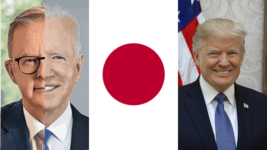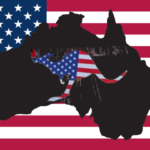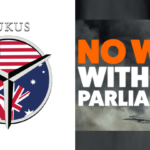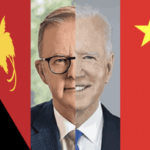Japan to Join Broadening US Force Posture in North Australia, Unless Trump Pulls the Plug

The 17th Trilateral Defence Ministers’ Meeting involving Australia, the US and Japan took place in Darwin on Sunday, 17 November, marking the first such meeting on local soil, and the big announcement of the day was that regular deployments of Japan’s Amphibious Rapid Deployment Brigade will be stationed in the Northern Territory, alongside Australian and United States troops.
Washington has had troops stationed in Darwin at the Obama administration’s behest, as part of the 2011 US pivot to Asia, which has since seen around 2,500 US Marines on permanent rotation through the NT, as part of a number of US forced posture initiatives on this continent made official in 2014, with the ultimate aim of waging a war against China in aid of waning US economic hegemony.
The proposal to include Japan in the local Australian and US presence in the NT was spruiked at the December 2022 AUSMIN meeting in Brisbane. Last Sunday’s Darwin meeting saw other aspects underlining this broadening of AUKUS aired, which include the potential trigger for war on China being its suggested invasion of Taiwan, as well as that all three nations join each other’s war games.
“This is going to build interoperability between our two countries – between our three countries – I should say,” Australian defence minister Richard Marles said on Sunday. He added that “it’s an important statement to the region and to the world about the commitment that our three countries have in working with each other.”
And in response to a question about ongoing local fears that the US won’t meet the production requirements needed to supply this nation with several US Virginia class submarines over the 2030s, along with whether the AUKUS pact will survive the transition to the Trump administration early next year, US defence secretary Lloyd Austin assured that there are no reasons for concern.
Tossing them the keys
“We’ve announced trilateral cooperation on F-35s. We’re working to integrate Japan into US-Australia force posture cooperation in Australia. And Japan and Australia have exercised their reciprocal access agreement through deployments to each other’s countries,” Austin told the press on Sunday, as he listed a series of initiatives designed to forge a multistate military force in the NT.
The US defence secretary confirmed that “Darwin is a focal point” for the expanding cooperation between the three nations, which will see Japan basically incorporated into the US Marine Rotational Force Darwin in northern Australia, and he again pressed on the principle of “interoperability” that underpins the ever-expanding AUKUS pact.
Interoperability refers to the forces of different nations acting together effectively in military operations. The importance of interoperability in local US force posture initiatives has repeatedly been expressed by US and Australian ministers since the onset of AUKUS, while this mixing of militaries has increasingly appeared to translate as US command over Australian forces.
Force posture is the ability of a military to launch a military action outside of its regular jurisdiction. The Abbott government formalised the initiatives under the 2014 Force Posture Agreement. There are three main initiatives that include marines stationed in the NT, increasing interoperability between each nation’s air force and it provides the US with unimpeded access to dozens of bases.
Washington takes control of these classified “agreed facilities and areas”, when it decides to upgrade one. The US is currently overhauling RAAF Base Tindal in the NT, which includes a storage facility for six nuclear-capable B-52 bombers, which are aimed at China. And as for whether they’ll be packing nukes, Australia abides by the US policy of warhead ambiguity, which means we’ll have no idea.
Marles was heard to brag at the AUSMIN conference in August this year that “American force posture now in Australia involves every domain: land, sea, air, cyber and space”.
AUKUS has failed us
The onslaught of US military presence and its trappings have hit overdrive since PM Anthony Albanese was in San Diego to launch the AUKUS optimal pathway in March last year. This was a path carved by his predecessor Scott Morrison, who launched AUKUS with Biden in 2021, around its then central feature, which was our nation acquiring eight nuclear-powered submarines (SSNs).
The idea that this nation would acquire this fleet of SSNs has long been sullied, as despite having invested AU$4.6 billion into the SSN industrial bases of both the US and the UK, they still have the ability to pull out at a year’s notice, while there are also provisions within US AUKUS legislation that allow it to renege on the provision of subs if it hasn’t first manufactured enough for itself.
But what appears guaranteed under AUKUS is Submarine Rotational Force-West (SRF-West), which is a permanent US-UK SSN presence at HMAS Stirling in Western Australia by 2027, which will involve 700 US Army personnel and families stationed there. And Albanese last month passed legislation that established two nuclear waste dumps: one at Stirling and the other south of Adelaide.
Another key AUKUS surprise is federal Labor has permitted this nation to be listed as a US domestic military source, which will make local minerals more accessible to Washington, right before the US is set to go hog-wild on tariffs under Trump.
No holds barred
Independent and Peaceful Australia Network (IPAN) spokesperson Justin Tutty said, “the announcement that Japan will join in with joint military exercises with USA and Australian forces should be of great concern to the Australian community.”
“Australia should be at the forefront of promoting peace in our region – not inviting more countries to join the AUKUS fold on Australian soil, which entails military intention to wage war against China,” the Darwin-based antiwar activist added.
IPAN further raised concerns that the decision of the Japanese government is in direct contravention of article 9 of the Japanese Constitution which “renounces war as a means to settle international disputes and prohibits Japan from maintaining military forces”.
Alongside Marles and Austin, last Sunday’s trilateral meeting in Darwin saw Japanese defence minister Gen Nakatani in attendance, which was the first time that a defence minister from that nation has attended the northern capital.
But along with Biden’s decision to shift his long-held position this week to greenlight Ukraine to fire long-range US missiles into Russian territory, the official decision to station Japanese troops in Darwin has the air of the outgoing Republication administration attempting to entrench some of its long-term military goals prior to a new government taking over.
And while Austin was able to put to bed concerns raised by a local journalist about whether US production would meet its goals, which would enable that nation to then supply ours with Virginia SSN, along with whether the incoming Trump administration will have the same vision for AUKUS as his administration, the expiring US defence secretary really can’t speak for this future.
Biden has long been set on establishing Australia as a forward base for an upcoming war on China, yet an incoming Trump administration appears more concerned about waging an economic war against Beijing via the imposition of a 60 percent tariff regime, while its other signature policy is the mass deportation of thousands of undocumented immigrants via the use of US military assets.







